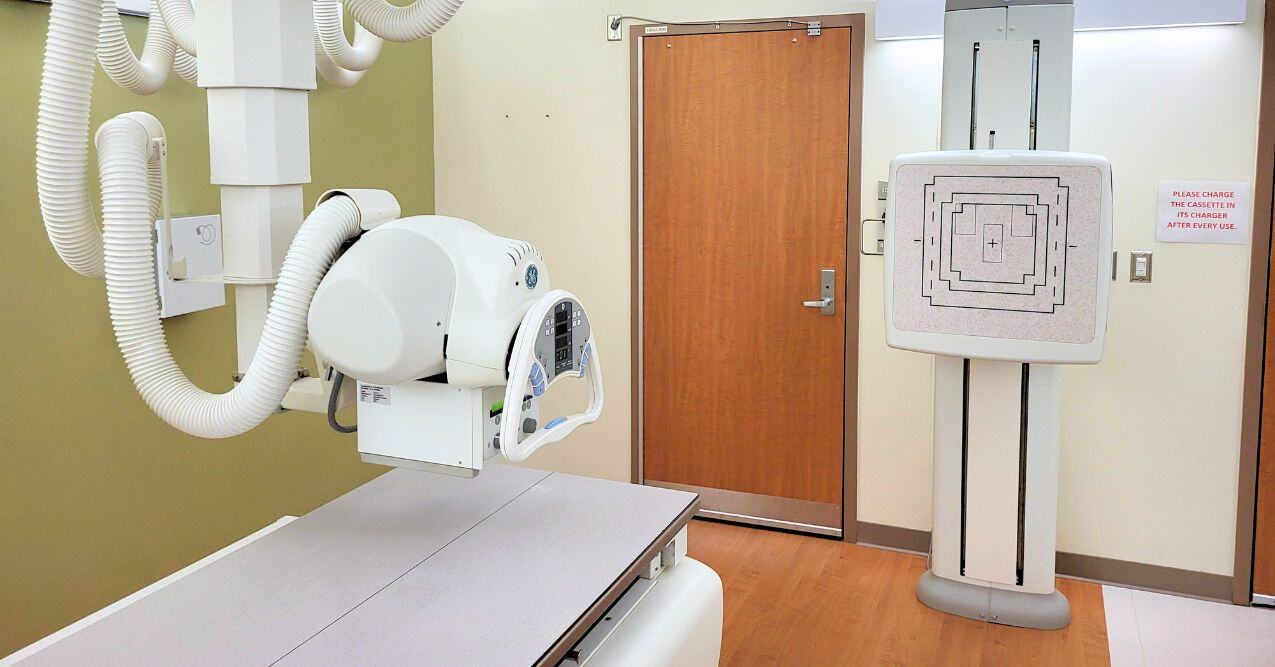
Updated: April 22, 2025 : 4 min read
Why Hospitals Keep Choosing R/F Rooms (Despite the Upfront Investment)
X-ray rooms come in all shapes and sizes, and one of the largest types is the R/F (radiographic fluoroscopy) room. Like two other modalities, C-arms and cath labs, R/F rooms use fluoroscopy, a common type of study used in imaging equipment that allows a physician to see a real-time video of the anatomy being imaged.
Among these three modalities that use fluoroscopy, R/F rooms are definitely the rarest, and yet, they are often viewed as a “must-have” piece of equipment. But how can R/F rooms be both rare and a must-have?
For hospitals in search of a specific rating, an R/F room is a necessary expense. Keep reading to understand the specifics of R/F rooms, the studies they perform, and why hospitals keep choosing R/F rooms despite the upfront investment.
Note: Block Imaging provides refurbished R/F room equipment and parts. You can read about it in detail below or reach out to our sales team to learn more about how it can help improve diagnostic imaging.
- What features do R/F rooms have?
- What studies are performed in R/F rooms?
- Why do hospitals and clinics invest in purchasing an R/F room?
- The takeaway
What Features do R/F rooms Have?
Most R/F rooms are found in hospitals or very large imaging centers. Due to the more specialized nature of the studies and costs associated with purchasing and operating, it is uncommon to find one in smaller clinics.
One of the key features that makes R/F rooms unique is the ability to tilt up to a 90-degree angle. This is necessary for studies that are imaging the full digestive system while in use. But that’s only one of many features that R/F rooms can boast of. Some others are:
Modernized Digital Technology. With a digital detector working together with the radiology and fluoroscopy sides, newer R/F rooms can achieve and save digital results immediately before sending to fax. Compare this to the workflow beforehand, where you were required to do a modern upgrade in order to save the media.
Pulsed Fluoroscopy - This feature emits radiation in bursts as opposed to a consistent stream, acting as another method to minimize patient radiation dose.
Dose Reduction - Each manufacturer has a proprietary name for their dose reduction features but each works toward the same end: minimizing the radiation dose for patients.
Virtual Collimation - This feature allows physicians to crop and shade images after the exposure is taken instead of needing to take an additional exposure after each adjustment of a mechanical collimator.
Remote Diagnostics - This option allows a service engineer to access the system’s computer terminal remotely to attempt diagnosis and resolution of error messages without a trip to the site.
Automatic Exposure Control (AEC) - AEC is a collection of preset kV and mA levels for a variety of common studies.
What studies are performed in R/F rooms?
The main studies performed with R/F rooms are swallow and gastrointestinal studies to ensure that food is being properly swallowed and digested. Barium is the most common contrast agent used. When used, its white color coats the anatomy being studied, making the image clearer. The contrast helps highlight areas in much greater detail than is achieved with a traditional X-ray.
A barium enema is another common exam performed on a R/F room to diagnose abnormalities, structural or functional, of the large intestine. As a result, it’s no surprise that R/F rooms’ versatility makes them desirable for hospitals with large caseloads for these needs.
Why do hospitals and clinics invest in having an R/F room?
R/F rooms are a significant investment and are rarely on the top of the list for a smaller system to purchase.
Brand new, these can be bought from the original OEM anywhere from $500,000 to $750,000+. Generally, you can expect a refurbished R/F room to be listed on the secondary market somewhere in the range of $225,000 - $300,000+ depending on the system, age, availability, and manufacturer, including installation and one year of full service.
R/F rooms also take a lot of power as opposed to C-arms, which can be just plugged into the wall, and the cost to repair an R/F room is much higher than the cost to repair a C-arm. Because of the power and repair costs needed, most smaller clinics choose not to take on this responsibility.
However, if you’re a hospital that is required to a certain rating that indicates you’re able to do those specialized studies, then you have to purchase an R/F room. Also, hospitals who have had the same R/F room for years are in a great spot to finally upgrade. Modern-day R/F rooms are increasingly easy to use, efficient, and meet or exceed industry standards for things like table capacity.
We talk to a lot of hospitals that have had the same R/F room for ten or more years and need to upgrade. However, when the OEM quotes them $500,000 - $750,000 or higher, they come to us for a refurbished option that fits within their budget and needs.
Hospitals find that R/F rooms are a sort of Swiss Army knife, performing the combination of studies that X-rays and C-arms can only do separately. In addition, R/F rooms’ fully digital capabilities work in tandem with the hospital’s network for today’s processes of saving and sharing imaging photos and videos.
In addition to fluoroscopy studies, R/F rooms can also be used for traditional radiology. While the II or flat panel detector is used for the fluoroscopy portion, another tube and receptor connected to the table can be used for X-rays.
Furthermore, a wall bucky is often included to allow for standing X-ray shots. This dual-purpose set-up allows flexibility and is a useful method of saving space and money. Hospitals opt for these systems because of these multifactored advantages.
The Takeaway
If you are a hospital or imaging center looking to add a R/F room to your facility, Block Imaging is ready to assist. Throughout the years we have purchased, sold, deinstalled, installed, and serviced hundreds of pieces of equipment within this specialized modality.
Walking this path with a trusted vendor like Block Imaging will give you confidence in venturing into the world of R/F. Be sure to download our R/F Room Guide for more valuable information on R/F room pricing breakdowns.

Clay Selby
Hello, I'm Clay, and I joined Block Imaging in 2021. I enjoy learning something new everyday about our industry and our customers. Block has an incredible work environment that fosters innovation and allows us to create unique solutions for our customers. Outside of work I love playing and watching sports, collect watches and drink craft coffee.






